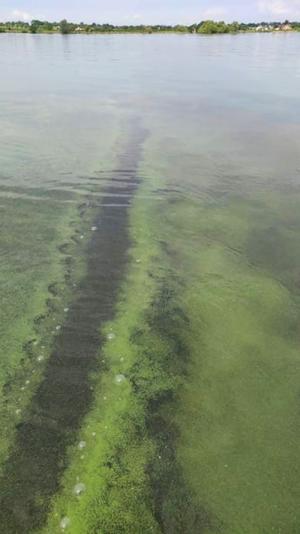Why has Lough Neagh been going green in the sun?
Date published:
In recent weeks, people living on, working around and visiting Lough Neagh have seen and commented on the presence of an extensive green layer on the Lough’s surface and have voiced their concerns about toxins affecting swimmers and dogs.

The green layer is an algal bloom, caused by the rapid growth and accumulation of blue-green algae which have flourished due to the period of warm, settled weather coupled with unusual levels of water clarity. Algal blooms can produce toxins and can also remove oxygen from the water as they decompose, which may be another cause for concern in the current warm weather. The current condition in the Lough is unusual in that these blue-green algae have not been abundant here since the mid-1970s.
AFBI routinely monitor temperature and oxygen levels throughout the Lough and have observed water temperatures steadily rising this summer. We recently recorded surface temperatures of 21oC, while average June surface temperatures in recent years have typically been around 15oC. Low oxygen levels in the Lough can also present challenging living conditions for wildlife. However, the oxygen levels we have measured to date are consistent with those required for fish to grow and thrive, and there have been no reports of any fish kills so far this year.
Observers of Lough Neagh will also have noticed that the water is currently clearer than usual. The clearer waters are likely due to the activity of zebra mussels, an invasive non-native species, first seen in Lough Neagh in 2005. The initial spread of the mussels was slow until around 2017, when a rapid increase occurred, and today large accumulations of adult zebra mussels can be found throughout the Lough. Zebra mussels feed by filtering particles from the water, and as a result remove food normally available to other species such as swan mussels. The resulting increased water clarity allows sunlight to penetrate deeper into the water, which can lead to increased nuisance plant and algal growth and allows prey species usually concealed by murky waters to become visible to their predators.
Both commercial and recreational fishers who fish for species including eel, trout and pollan, have been concerned about the possible impacts of current conditions on Lough fish stocks. Recent sonar surveys conducted by AFBI have shown that for now at least, most fish are remaining in their normal habitat near the bottom of the Lough. We recognise however that these unusual conditions may pose an ongoing risk to the fish and the broader lough ecosystem.
AFBI will continue to closely monitor the risks and ecological changes in Lough Neagh. As well as monitoring fish stocks, algal abundance and water quality, new equipment will provide real-time data on water temperature and dissolved oxygen levels. By remaining alert to rapidly evolving environmental conditions within the Lough Neagh ecosystem, we can promptly inform our scientific teams and stakeholders should conditions pose further cause for concern.
Notes to editors:
AFBI’s Vision is “Scientific excellence delivering impactful and sustainable outcomes for society, economy and the natural environment”.AFBI’s Purpose is “To deliver trusted, independent research, statutory and surveillance science and expert advice that addresses local and global challenges, informs government policy and industry decision making, and underpins a sustainable agri-food industry and the natural and marine environments”.AFBI’s core areas:Leading improvements in the agri-food industry to enhance its sustainability.Protecting animal, plant and human health.Enhancing the natural and marine environment.